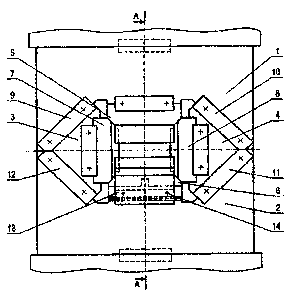Some of the information on this Web page has been provided by external sources. The Government of Canada is not responsible for the accuracy, reliability or currency of the information supplied by external sources. Users wishing to rely upon this information should consult directly with the source of the information. Content provided by external sources is not subject to official languages, privacy and accessibility requirements.
Any discrepancies in the text and image of the Claims and Abstract are due to differing posting times. Text of the Claims and Abstract are posted:
| (12) Patent Application: | (11) CA 2542185 |
|---|---|
| (54) English Title: | FOUR-HAMMER FORGING DEVICE |
| (54) French Title: | DISPOSITIF DE FORGEAGE A QUATRE FRAPPES DE MARTEAU |
| Status: | Deemed Abandoned and Beyond the Period of Reinstatement - Pending Response to Notice of Disregarded Communication |
| (51) International Patent Classification (IPC): |
|
|---|---|
| (72) Inventors : |
|
| (73) Owners : |
|
| (71) Applicants : |
|
| (74) Agent: | MACRAE & CO. |
| (74) Associate agent: | |
| (45) Issued: | |
| (86) PCT Filing Date: | 2004-10-12 |
| (87) Open to Public Inspection: | 2005-05-06 |
| Examination requested: | 2006-04-10 |
| Availability of licence: | N/A |
| Dedicated to the Public: | N/A |
| (25) Language of filing: | English |
| Patent Cooperation Treaty (PCT): | Yes |
|---|---|
| (86) PCT Filing Number: | PCT/RU2004/000399 |
| (87) International Publication Number: | WO 2005039802 |
| (85) National Entry: | 2006-04-10 |
| (30) Application Priority Data: | ||||||
|---|---|---|---|---|---|---|
|
The invention relates to metal forming and can be used for forging billets and
blanks by means of hydraulic forging presses. The inventive device comprises
two holders for top and lower hammers and two holders for side hammers which
are cinematically connected thereto. Each top and lower hammer is provided
with two working surfaces separated by a recess in which the working surfaces
of the side hammers penetrate. At least one adjusting plate is arranged
between the lower hammer and the holder thereof. Said lower hammer is fixed to
the holder by two L-shaped clamps which are pressed by the inclined faces
thereof against the inclined faces of the lower hammer holder and by the wavy
faces thereof against two friction plates which are made, for example of
copper and fixed to the side surfaces on the lower hammer. Pins which are
fixed in the lower hammer pass through the holes of the adjusting plates and
penetrate into the holes of the lower hammer holder.
L'invention appartient au domaine du traitement des métaux par pression et peut s'utiliser dans le forgeage de lingots et d'ébauches dans des presses de forgeage. Le dispositif comprend deux supports des frappes supérieure et inférieure et deux supports des frappes latérales, reliés cinématiquement aux supports des deux premières frappes. Les supports des frappes latérales possèdent des surfaces inclinées qui correspondent aux surfaces inclinées des supports des frappes inférieure et supérieure. Les frappes inférieure et supérieure comprennent chacune deux zones de travail, séparées par une partie découpée dans laquelle rentrent des zones de travail des frappes latérales. Entre la frappe inférieure et son support on a monté au moins une plaque de réglage. La frappe inférieure est solidarisée à la fixation au moyen de deux pinces en L, qui sont pressées par leurs surfaces inclinées contre les surfaces inclinées de la frappe inférieure, et sont pressées par leurs surfaces hachurées contre deux plaques de frottement faites, par exemple, en cuivre et fixées sur les surfaces latérales de la frappe inférieure. Dans la frappe inférieure on a monté des tiges qui passent à travers les trous des plaques de réglage et rentrent dans les trous du support de la frappe inférieure.
Note: Claims are shown in the official language in which they were submitted.
Note: Descriptions are shown in the official language in which they were submitted.

2024-08-01:As part of the Next Generation Patents (NGP) transition, the Canadian Patents Database (CPD) now contains a more detailed Event History, which replicates the Event Log of our new back-office solution.
Please note that "Inactive:" events refers to events no longer in use in our new back-office solution.
For a clearer understanding of the status of the application/patent presented on this page, the site Disclaimer , as well as the definitions for Patent , Event History , Maintenance Fee and Payment History should be consulted.
| Description | Date |
|---|---|
| Application Not Reinstated by Deadline | 2007-10-12 |
| Time Limit for Reversal Expired | 2007-10-12 |
| Deemed Abandoned - Failure to Respond to Maintenance Fee Notice | 2006-10-12 |
| Inactive: Cover page published | 2006-06-22 |
| Letter Sent | 2006-06-14 |
| Inactive: Acknowledgment of national entry - RFE | 2006-06-14 |
| Letter Sent | 2006-06-14 |
| Application Received - PCT | 2006-05-11 |
| National Entry Requirements Determined Compliant | 2006-04-10 |
| Request for Examination Requirements Determined Compliant | 2006-04-10 |
| All Requirements for Examination Determined Compliant | 2006-04-10 |
| Application Published (Open to Public Inspection) | 2005-05-06 |
| Abandonment Date | Reason | Reinstatement Date |
|---|---|---|
| 2006-10-12 |
| Fee Type | Anniversary Year | Due Date | Paid Date |
|---|---|---|---|
| Request for examination - standard | 2006-04-10 | ||
| Basic national fee - standard | 2006-04-10 | ||
| Registration of a document | 2006-04-10 |
Note: Records showing the ownership history in alphabetical order.
| Current Owners on Record |
|---|
| JOINT STOCK COMPANY "CHEPETSKIY MECHANICAL PLANT" |
| Past Owners on Record |
|---|
| ANATOLIY FRANTSEVICH LOSITSKIY |
| GENNADIY SERGEEVICH CHEREMNYCH |
| IGOR VIKTOROVICH NOZDRIN |
| SERGEY GENNADYEVICH AHTONOV |
| SVETLANA ALEXANDROVNA LAZORKINA |
| VICTOR ANDREEVICH LAZORKIN |
| VLADIMIR BORISOVICH PHILIPPOV |
| VLADIMIR VLADIMIROVICH ROZHDESTVENSKIY |